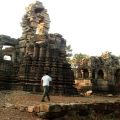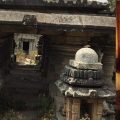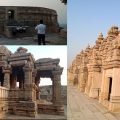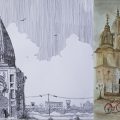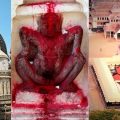Khajuraho Temples Depict Dharma, Kama, Artha, and Moksh. Why Only Kama Highlighted?
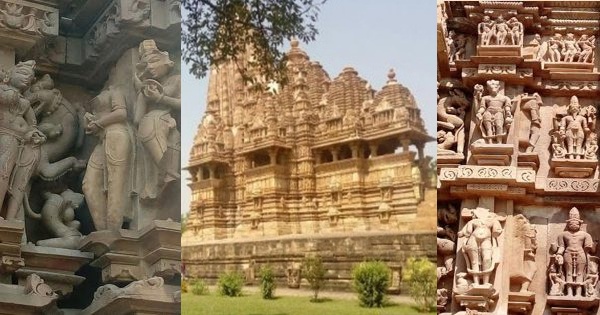
Your very footsteps in the premises of Khajuraho temples will ship you to the kingdom of the Chandel rulers of the 10th and 11th centuries. The exquisiteness and grandeur of the temples all around, visible from a distance, could not be expressed in words! As you walk in silent steps towards the temples, you will certainly fall in love with India’s rich heritage. Architectural and sculptural splendor at their zenith! The architects, masons, sculptors, designers, and manual workers were so gifted!!
As you explore Khajuraho temples one by one, your eyes will rummage around for the sculptures that the temples have been made famous for. Eroticism! In booklets, in magazines, in tour advertisements, and almost everywhere in digital and print medium – this single trait symbolized the town and the temples! Yes, they are there but only at a miniscule level portrayed in proportional balance. They are scarcely highlighted. You cannot find them until you look closely to uncover them.
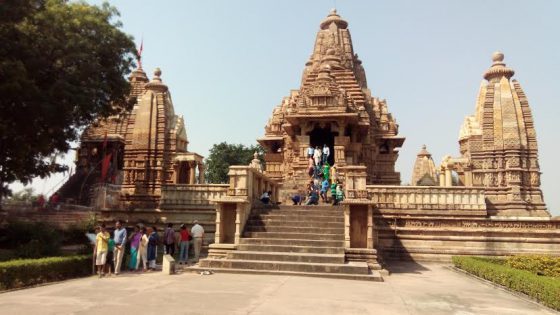
Only less than 10% of eroticism is displayed in the artwork and sculptures. Why the hullabaloo in our home country and abroad? Is it a tourism promotion gimmick?
The sculptures in all the temples of Khajuraho symbolically depict the four goals or philosophies of life, called Purusarth (objective of human pursuit) in Hinduism – Dharma, Kama, Artha, and Moksh.
Dharma signifies virtuous life including duties and conduct. In short, it denotes the right way of living. Kama represents desire, sensuality, emotional fulfillment, wish, sexual desires, and procreation. It forms the base of the multiplication of the human race, generation to generation. Artha connotes means of livelihood and material prosperity. It also implies ‘means of life’. Moksh is self-realization. It refers to self knowledge. It implies freedom from ignorance. Moksh also refers to liberation from the cycle of birth and death. Why only Kama philosophy is highlighted for promotion of tourism ignoring the rest of the three goals?
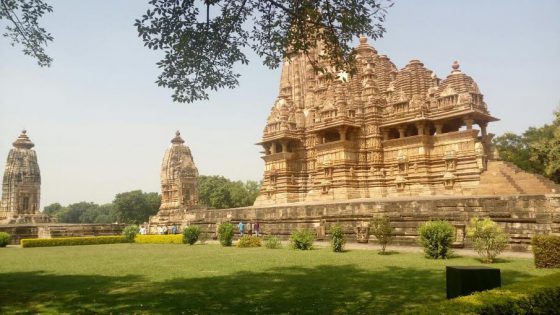
Besides the four goals, the artwork in the temples of Khajuraho depicts Hindu Gods and Goddesses. It also represents routine activities of the people of the Chandel period. It portrays how soldiers marched towards the battlefield, types of weapons used, animals taking part in war (wild boar, horses, and elephants were common), and war scenes. The sculptures show women involved in beautifying themselves, using vermilion in the forehead, catching hold of small mirrors, applying kajal in the eyes, etc.
The base artwork exemplifying the concept of bure nazar wale tera mooh kala is a visible sign in all of the Khajuraho temples. Keechak, the army commander of King Virat of Matsya of Mahabharat fame, is visible bearing the weight of the temple at the entrance of the shrines. Matsya was the kingdom where the Pandavs, disguised, hid during their exile. Keechak was believed to possess the strength of 100 elephants. With all of these descriptions, eroticism comprises less than 10%.
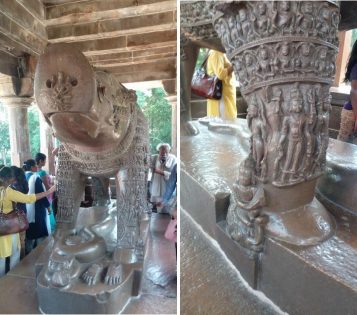
Varaha Statue
Hinduism is well glorified with most of the temples dedicated to Mahadev and Goddess Parvati; Bhagwan Vishnu and His incarnations including Shree Ganesha and Surya Dev. There are three temples dedicated to Jain Tirthankars.
A colossal monolithic statuette of the Varaha Avatar of Lord Vishnu, standing tall within the Varaha Temple is a major attraction. The temple, built entirely of sandstone, rests on a lofty plinth. It is an oblong pavilion with a pyramid shaped roof of receding tiers. The tiers rest on 14 plain pillars. Information about the shrine displayed at the entrance suggests its construction dating back to 900-925 AD. The intricate carvings all over the statuette are a feast for the eyes.
The Chaunsath Yogini (64 Goddesses, all aspects of Goddess Durga) temple is the oldest in the group, dating back to the 6thcentury AD, preceding the Chandel period. It was probably built by the Gurjar Pratihars. Located on a 5.4 meter high platform, the shrine has a rectangular plan with an open courtyard at the center.
Originally, there were 65 cells, each cell comprising of a small doorway and a curvilinear tower. Only 35 of these cells have survived. Out of these cells, one cell is the largest. Located on the centre of the back wall, this cell is believed to contain the image of Goddess Durga. Tantriks visit the temple to offer prayers to the Goddesses.
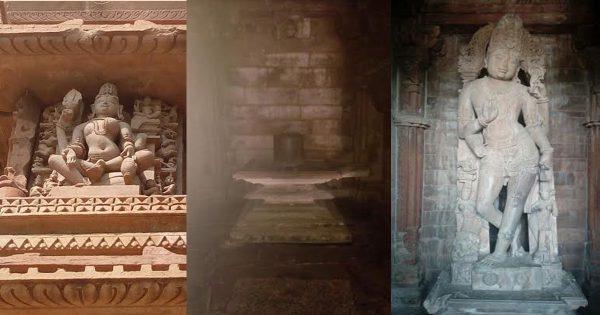
The Kandariya Mahadev temple is spread over an area of about 6,500 square feet with its spire rising at 116 feet. Signs of worship are visible in the Matangeshvara shrine, a square grid temple with the Shivling at 8.2 ft high and 3.6 ft diameter placed on a 25 ft diameter platform.
Except the Chaturbhuj temple, all of the Khajuraho temples face sunrise. They exhibit Nagara architectural style. Square and circle symbols suggesting Hindu mandal design, are present in all the temples.
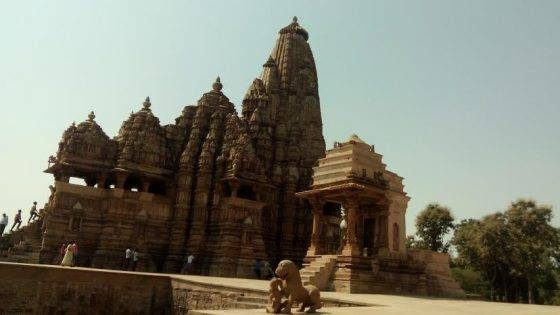
Vastu principles are imbibed in each temple with the territory laid out in three triangles that converge to form a pentagon. With the foundation in granite, which are concealed and the temples in sandstone, it is gravity that holds the precise tenon joints in place. No use of mortar but mortise! Columns and architraves were erected with megaliths. What grand and innovative ideas the builders and architects of the bygone days were endowed with!
There were 85 grand temples; only 25 have survived destruction by Muslim plunderers and the ravages of time. Signs of destruction are visible in all. Qutb-ud-din Aibak attacked the Chandel kingdom during the end of the 12th century. He plundered the temples. In 1495, Sikandar Lodi further destroyed the temples. Many statues, idols, and exterior walls have been mutilated and disfigured. Many temples were razed to the ground.
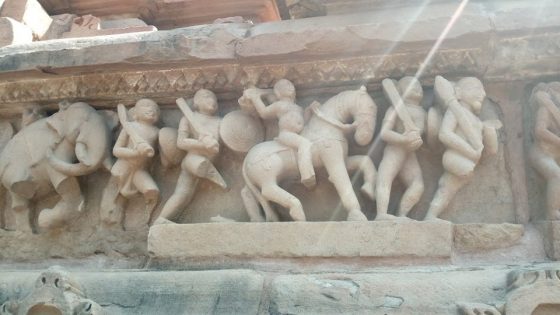
Mahmud of Ghazni during his raid of Kalinjar in 1022 AD did plan to plunder the Khajuraho group of temples. The then Hindu king paid a ransom to end the attack. Later, to preserve the temples from Muslim plunderers, the people of Khajuraho kept the temples under isolation under forest cover. The present few temples that have survived are because of this.
The tourism sector should highlight all factors rather than promoting the sexual symbols in the sculptures of Khajuraho temples!
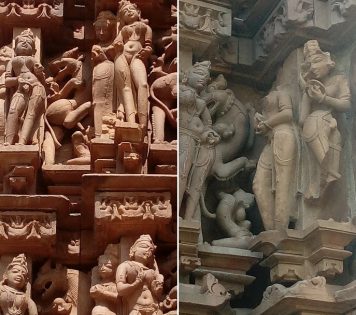
All images clicked by the author.
Latest posts by manoshi sinha (see all)
- What if Shaikh Paltu had Helped Mangal Panday instead of British? - November 23, 2024
- Shivaleela: Celebration of Shiva in this 21st Century Gurukul - November 23, 2024
- INA Veteran Lt Madhvan Appeals for Installation of Statue of Rash Behari Bose in Delhi - November 23, 2024


